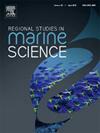Delineation of outbreak stages of the coral-killing sponge Terpios hoshinota
IF 2.1
4区 环境科学与生态学
Q3 ECOLOGY
引用次数: 0
Abstract
Outbreaks of the cyanobacteriosponge Terpios hoshinota are one of the many issues contributing to coral reef decline in the Indo-Pacific. This species occasionally undergoes local outbreaks, becoming an aggressive space competitor and overgrowing and killing zooxanthellate corals. Large outbreaks have been observed in Taiwan and the Ryukyu Islands in southern Japan. Many questions regarding the characteristics and chronology of T. hoshinota outbreaks remain unsolved. Therefore, the aim of this research was to identify outbreak stages at an outbreak site (Ogimi) on the west coast of northern Okinawa Island, Japan. We developed a novel approach to understand the chronology of outbreaks. Distinct outbreak stages were defined based on observations, in which Terpios: 1) starts overgrowing coral colonies, 2) covers a whole coral colony, 3) in the case of branching corals, causes the coral colony to collapse, and 4) the sponge is eventually overgrown by other organisms including turf algae and other sponges. Analyses were done based on photographic transects and the relative proportions of each stage were calculated. Results showed Ogimi is likely in final outbreak stages as overgrown Terpios had the highest share of all stages (57.9 % and 44.9 % at two outbreak sites), while smaller patches of Terpios, marking the starting point of the successional process, made up less than 1.5 % of all observations. We suggest collecting such stage information during Terpios monitoring as it can allow identification of outbreaks at early stages, and potentially identify global patterns.
珊瑚杀手海绵Terpios hoshinota爆发阶段的划分
本文章由计算机程序翻译,如有差异,请以英文原文为准。
求助全文
约1分钟内获得全文
求助全文
来源期刊

Regional Studies in Marine Science
Agricultural and Biological Sciences-Ecology, Evolution, Behavior and Systematics
CiteScore
3.90
自引率
4.80%
发文量
336
审稿时长
69 days
期刊介绍:
REGIONAL STUDIES IN MARINE SCIENCE will publish scientifically sound papers on regional aspects of maritime and marine resources in estuaries, coastal zones, continental shelf, the seas and oceans.
 求助内容:
求助内容: 应助结果提醒方式:
应助结果提醒方式:


